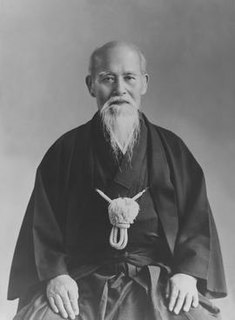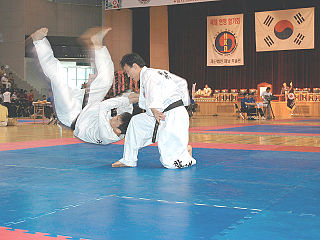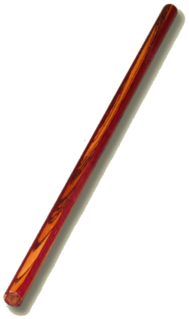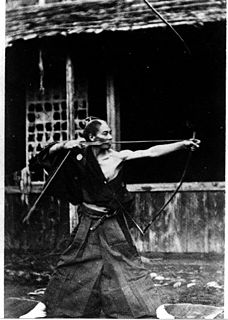
Aikido[aikiꜜdoː] is a modern Japanese martial art developed by Morihei Ueshiba as a synthesis of his martial studies, philosophy, and religious beliefs. Ueshiba's goal was to create an art that practitioners could use to defend themselves while also protecting their attacker from injury. Aikido is often translated as "the way of unifying (with) life energy" or as "the way of harmonious spirit".

Morihei Ueshiba was a martial artist and founder of the Japanese martial art of aikido. He is often referred to as "the founder" Kaiso (開祖) or Ōsensei (大先生/翁先生), "Great Teacher".

Hapkido is a highly eclectic Korean martial art. It is a form of self-defense that employs joint locks, grappling, and throwing techniques similar to those of other martial arts, as well as kicks, punches, and other striking attacks. It also teaches the use of traditional weapons, including knife, sword, rope, ssang juhl bong (nunchaku), cane, short stick, and middle-length staff, which vary in emphasis depending on the particular tradition examined.

Daitō-ryū Aiki-jūjutsu (大東流合気柔術), originally called Daitō-ryū Jujutsu, is a Japanese martial art that first became widely known in the early 20th century under the headmastership of Takeda Sōkaku. Takeda had extensive training in several martial arts and referred to the style he taught as "Daitō-ryū". Although the school's traditions claim to extend back centuries in Japanese history there are no known extant records regarding the ryū before Takeda. Whether Takeda is regarded as either the restorer or the founder of the art, the known history of Daitō-ryū begins with him. Takeda's best-known student was Morihei Ueshiba, the founder of Aikido.

The hanbō is a staff used in martial arts. Traditionally, the hanbō was approximately three shaku or about 90 centimetres (35 in) long, half the length of the usual staff, the rokushakubō. Diameter was 2.4 to 3 centimetres. However, depending on the school the length and diameter varied.

Uchida Ryōgorō Shigeyoshi, , was a Japanese jojutsu practitioner, ranked menkyo in the Japanese martial art of Shintō Musō-ryū. He is the creator of the gendai budo Uchida Ryu Tanjojutsu, originally known as Sutteki jutsu or "stick method".
Ittō-ryū (一刀流), meaning "one-sword school", is the ancestor school of several Japanese Koryū kenjutsu styles, including Ono-ha, Mizoguchi-ha, Nakanishi-ha, Kogen, Hokushin, and Itto Shoden. The style was developed by Ittōsai Kagehisa.
Jujutsu techniques include joint locks, chokeholds, strikes, grappling, throwing and other self-defense techniques.

Takeda Sōkaku was known as the founder of a school of jujutsu known as Daitō-ryū Aiki-jūjutsu.
Shōgen Okabayashi was a well known Kansai based aikijujutsu teacher.
Toda-ha Bukō-ryū (戸田派武甲流) is a Japanese koryū martial art which has its roots in the Toda-ryū, founded in the late Muromachi period c. 1560 by Toda Seigen.

Kyūjutsu (弓術) is the traditional Japanese martial art of wielding a bow (yumi) as practiced by the samurai class of feudal Japan. Although the samurai are perhaps best known for their swordsmanship with a katana (kenjutsu), kyūjutsu was actually considered a more vital skill for a significant portion of Japanese history. During the majority of the Kamakura period through the Muromachi period (c.1185–c.1568), the bow was almost exclusively the symbol of the professional warrior, and way of life of the warrior was referred to as "the way of the horse and bow".
The oldest line of Yōshin-ryū (楊心流) is probably the school founded by Nakamura Sakyōdayū Yoshikuni around 1610, and is often referred to as Yōshin Koryū (楊心古流). Nakamura later changed his name to Miura Yōshin, and this school may also be referred to as Miura-ryū (三浦流), or Miura Yōshin-ryū (三浦楊心流). This line has a historical connection to the Takeda family through the founder's grandfather, Nakamura Yorifusa. Yorifusa was a retainer of the Koshu Takeda who founded a school of jujutsu called Taiyo ryu. Yoshin Koryu was founded by Nakamura Yoshikuni in Nagasaki after being driven from Takeda lands by Tokugawa Ieyasu. It is stated that Yoshin Koryu was a mixture of Taiyo ryu and knowledge gained by Yoshikuni’s exposure to Chinese martial arts and medicine, knowledge gained while living in Nagasaki and in nearby Miura village.

Jujutsu, also known as Jujitsu or Jiu-jitsu, is a Japanese martial art and a method of close combat for defeating an opponent in which one uses either a short weapon or none.
Jūkenpo is a Japanese martial art. Its name can be translated as "the Way of the soft fist" or "the soft boxing".
Fusen-ryū is a Japanese martial arts koryū founded by Motsugai Takeda. It contains a complete system of martial arts, including unarmed fighting (jujutsu), staff (bōjutsu), short staff (jojutsu), sword (kenjutsu), sword drawing (iaijutsu), glaive (naginatajutsu), scythe (nagikamajutsu), scythe and chain (kusarigamajutsu) and jitte (jittejutsu).

The rivalry between the Kodokan school of judo and the Totsuka school of Yoshin-ryu jujutsu happened at the 1880s during the Meiji Restoration in Japan. Composed by several challenges and tournaments, and its result saw the decline of the traditional jujutsu schools and the rise of judo as an institutionalized martial art. Although surrounded in controversy and legend due to inconsistent sources, it has been considered a vital part of the history of judo.













